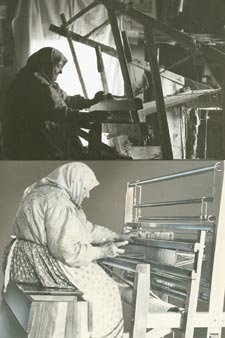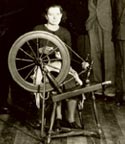|
|
|
 |
Top photo shows the old loom.
Bottom photo shows the improved design loom
|
Oscar A. Bériau
In 1905 Oscar Alphonse Bériau, with a degree in chemistry, began working
at the Québec Parliament as a private secretary for the Treasury. By
1910 he was an inspector of revenue. He met and married Marie Elizabeth
Couture. They had eleven children of which four died before the age
of three. His involvement began after visiting Elizabeth’s old aunt
in Bellchasse. He saw her ancient loom with a mess of string and leather
harnesses. He never wove himself, but just by looking he understood
the mechanics and drew up new ideas for a loom.
Leclerc Looms
Through the intervention of Bériau, the Minister of Agriculture, asked
Nilus Leclerc, master carpenter, to make a loom, which would be designed
and sized to fit in a typical home. The four-harness counterbalance
loom’s design was based on the Normandy design barn loom his father,
Leclerc, built for a brother. One of the innovations was to adapt an
old circular saw blade. To keep the tension, the blade’s teeth grab
the warp beam and lock it in place. At the 1926 Québec Exposition Leclerc’s
new loom was demonstrated by Emilie Chamard, a prominent weaver, teacher
and consultant to Bériau. Her assistant was Nilus’s nine-year-old son
Robert.

L’Ecole des Arts Domestique
Bériau had found that every aspect of the weaving process needed to
be improved, including the wool. As a result of the 1929 report, the
Québec Assembly authorized the foundation of L’Ecole des Arts Domestique
(Provincial School for Handicrafts) with Bériau its director on April
4, 1930, marking the beginning of the Québec Renaissance.(13)
At the Parliament the 1st Provincial Exhibition of domestic and foreign
handicrafts opened. Ministers and the public were invited to view the
collection, over 2500 examples. Bériau’s two youngest daughters and
a niece presented flowers to the dignitaries, wearing dresses their
mother and aunt made for the occasion.
The intent of the exhibit was to examine the hand techniques and workmanship.
The pieces included wood sculptures and toys from France, pottery from
Brittany and Alsace, Navaho crafts, linens from Ireland, Flanders, and
Russia, aprons from Czechoslovakia, rugs from Spain, Ukraine, Norway
and China, batik from New Jersey, forged iron and embossed leather from
Turin, etc. All the works faithfully represented their traditions, each
the national pride of the country represented”.(14)
July 10, 1930
On July 10 the school opened with 59 students: nuns from HSS and presidents
of the CDF. “The new school was equipped with rooms for all aspects
of weaving. The laboratory was equipped to measure and test textile
fibers. A museum to catalogue foreign country arts, ceramics and for
research and conservation methods for those working in isolation on
certain works: point  boutonné,
ceinture fléchée, quilting, and catalogues European and North American
teachers were in residence for four years(15)
including Emilie Chamard, who was widely regarded as one of the guardians
for Québec’s weaving heritage, and the vanguard of the return to traditional
arts and crafts.(16) Chamard, a sturdy
woman, claimed that Bériau sent her out, sometimes by horse, into the
rural areas because she was so robust. boutonné,
ceinture fléchée, quilting, and catalogues European and North American
teachers were in residence for four years(15)
including Emilie Chamard, who was widely regarded as one of the guardians
for Québec’s weaving heritage, and the vanguard of the return to traditional
arts and crafts.(16) Chamard, a sturdy
woman, claimed that Bériau sent her out, sometimes by horse, into the
rural areas because she was so robust.
The curriculum included care, preparation, and classifying the various
qualities of flax and wool according to the breed of sheep. The students
were introduced to all aspects of weaving with modifications to the
craft using Leclerc looms. Each kept samples spinning, weaving and rug
making in their album. The cloth produced included: clothing, house
linens, car coverings, and draperies. Many patterns were used: point
and broken twill, abeilles, gauffre, basket weave, double weave. Rugs
were woven, hooked, and crocheted. Tapestries were made on Gobelins-style
vertical looms. Two graduates of the School of Fine Arts set up a studio
on how to prepare students drawings. Bériau taught the dyeing course
using indigenous natural materials that could be made in any kitchen.
Durability tests of dyed fabric were placed on the flat roof of his
home. He published La Teinturerie Domestique (Home Dyeing) a recipe
book. In 1933 he published Tissage Domestique; in 1939 the English edition
of Home Weaving with over 200 pages of diagrams, building plans, photographs
and patterns, many designed by Bériau. This book became the bible for
many Canadian weavers.
Teachers were sent to all parts of the province, welcomed by the CDF,
including mining towns and outposts. Teacher taught at the Institute
of the Deaf-Mute, Montréal, the Victor Doré School and the Villeneuve
School for disabled and epileptics, both in Québec City. Bériau’s dauther
Renée and his niece Ninette Lachance taught at the Institute of the
Blind, Nazareth, Montréal using a special process to determine the fibers
and colors. Bériau share the observations of the teachers with Leclerc
to make improvements. The school’s enrollment grew to over 21,000 students
including 7,000 in a three months period in 1933.(17)
To improve the materials Bériau went to Dominion Textiles to develop
stronger cotton for weaving warp. In 1932, he traveled to Belgium to
tour and study the flax growing and linen manufacturing process. In
France he met Rodier, the great French designer for tapestries who was
amazed at the variety of patterns that the Leclerc loom could make.
Bériau’s trip help pass legislation for special protection for Québec’s
textiles. Bériau became an advisor to The Flax Growers of Québec.
Ceramics Too
To improve pottery, in 1933, Bériau established the Beauce Ceramic Project
where young farmers, provided with plans, built homes, barns and workshops
on ten-acre lots provided by the province. Trained in agriculture and
in pottery as well as in French, English, math, drawing, modeling, and
carpentry, they farmed in the summer and made pottery to occupy the
winter months and provide additional revenue. They built their own furniture
including weaving looms to give to their future brides. “The economic
benefits of this project could not be overlooked, of greater importance
were the educational and moral values. The craftsman learned to develop
a keen sense of observation, cultivated his taste. His craft was influenced
by the rural atmosphere, his traditions and his temperament helped him
to create new forms”.(18)
Word Spread
Schools, training centers, governments, and corporations would seek
out and request Bériau’s expertise in setting up handicraft training
programs. In 1935, Bériau was awarded the Royal Silver Jubilee Medal
from King George V, of England in recognition for his singular contribution
as the leader of the revival in handicrafts in Canada.(19)
Around 1937 Mrs. Eleanor Roosevelt asked Bériau to recreating the Québec
program in the U.S. Because it would relocate his family he declined
(20).
To continue this article click on Advisor.
References for this site
Top of this page
©Jean-Paul Picard 2001-09
ALL RIGHTS RESERVED
|




 boutonné,
ceinture fléchée, quilting, and catalogues European and North American
teachers were in residence for four years(15)
including Emilie Chamard, who was widely regarded as one of the guardians
for Québec’s weaving heritage, and the vanguard of the return to traditional
arts and crafts.(16) Chamard, a sturdy
woman, claimed that Bériau sent her out, sometimes by horse, into the
rural areas because she was so robust.
boutonné,
ceinture fléchée, quilting, and catalogues European and North American
teachers were in residence for four years(15)
including Emilie Chamard, who was widely regarded as one of the guardians
for Québec’s weaving heritage, and the vanguard of the return to traditional
arts and crafts.(16) Chamard, a sturdy
woman, claimed that Bériau sent her out, sometimes by horse, into the
rural areas because she was so robust.